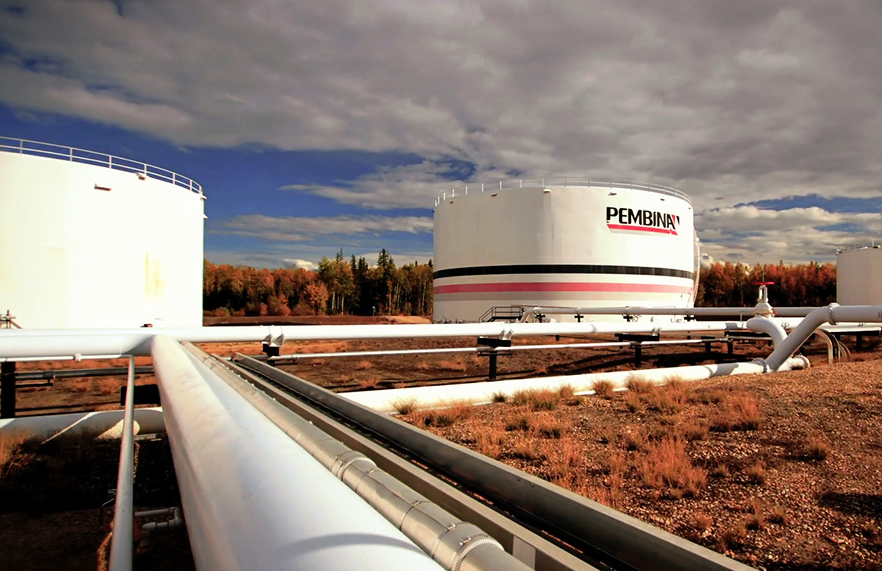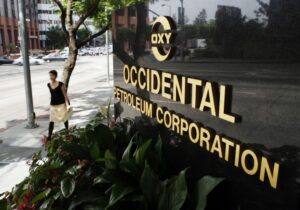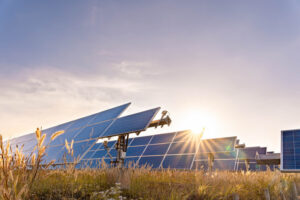
(Pembina, 11.Dec.2023) — Pembina Pipeline Corporation (TSX: PPL; NYSE: PBA) announced its 2024 financial guidance and provided a business update.
Highlights
- 2024 adjusted EBITDA guidance of $3.725bn to $4.025bn, driven by continued volume growth across the Western Canadian Sedimentary Basin (“WCSB”), new assets placed into service, re-contracting of certain assets, and the prevailing commodity price outlook.
- 2024 capital investment program of $880mn reflects growing volumes and Pembina’s commitment to providing safe, reliable, flexible, and cost-effective energy infrastructure solutions.
- At the midpoint of the company’s guidance range the 2024 capital investment program is expected to be fully funded with cash flow from operating activities, net of dividends.
- Continued accretive investment opportunities in the core business, highlighted by the sanctioning of a new cogeneration facility at the Kaybob South 3 Processing Plant (the “K3 Plant”) by Pembina Gas Infrastructure (“PGI”), and continued investment in northeast British Columbia (“NEBC”) liquids egress. Pembina continues to progress the previously disclosed 40,000 barrels per day (“bpd”) expansion of its NEBC Pipeline system and evaluate additional pipeline and terminal infrastructure in the region.
- Pembina is in development of additional growth projects, which could add up to $280mn to the 2024 capital investment program, inclusive of pre-final investment decision (“FID”) contributions related to the Cedar LNG project (“Cedar LNG”).
- Consistent financial leadership demonstrated by Pembina’s commitment to its financial guardrails, its low-risk and primarily fee-based business with high take-or-pay or cost-of-service contributions, and strong leverage metrics, including a forecasted year-end 2024 proportionately consolidated debt-to-adjusted EBITDA ratio of 3.3 to 3.6 times.
Business Update
The predictability and resilience of Pembina’s business is being demonstrated once again in 2023 with the expectation of another record setting financial year. Strong results reflect growing volumes and rising capacity utilization across many key systems. In Pembina’s conventional pipelines business, which is a proxy for the broader WCSB, second half 2023 volumes are expected to be five percent higher than the same period in 2022. The investments Pembina has made in recent years, including various expansions of the Peace Pipeline system and the transaction to form PGI have created the capacity to accommodate rising throughput, leading to highly accretive growth in Pembina’s business. In addition, Pembina’s growing platform and favorable commodity prices and price spreads have allowed its marketing business to outperform the historical average.
Momentum within the WCSB is expected to continue into 2024 and beyond and Pembina is well positioned to benefit from what it expects to be a transformational period in the Canadian energy industry. Over the next several years, Pembina sees the potential for mid-single digit annual volume growth across the WCSB, driven by near term catalysts, including up to approximately 2.8billion cubic feet per day of new natural gas export capacity from new West Coast LNG projects, 590,000 bpd of new crude oil export capacity from the expected completion of the Trans Mountain Pipeline expansion, as well as potential new developments in the Alberta petrochemical industry, including Pembina’s expectation of more than 100,000 bpd of incremental ethane demand associated with Dow Inc.’s recent decision to build a new 1.8 million metric tonne per annum integrated ethylene cracker and derivatives facility in Fort Saskatchewan.
Given the scope and reach of its assets, highly economic expansion opportunities, existing long-term contracts, and agreements with three premier NEBC producers, Pembina is uniquely positioned to capture new volumes and benefit from the growth in the WCSB. Pembina will continue to invest in infrastructure to serve customers and enhance its integrated value chain, while also pursuing opportunities in the new ventures portfolio that align with the Company’s strategy to enhance access to global markets and better align its future with the transition to a lower-carbon economy. Specific highlights include:
- PGI is proceeding with the development of a 28 MW cogeneration facility at its K3 Plant (the “K3 Cogeneration Facility”), which is expected to reduce overall operating costs by providing power and heat to the gas processing facility, while reducing customers’ exposure to power prices. The K3 Cogeneration Facility is expected to fully supply the K3 Plant’s power requirements, with excess power sold to the grid at market rates. Further, this project is expected to contribute to a reduction in annual emissions compliance costs at the K3 Plant through the utilization of the cogeneration waste heat and the low-emission power generated. These attributes are expected to enhance the K3 Plant’s competitiveness and potential to attract further incremental volumes in the area.
The project is expected to cost approximately $70mn (net to Pembina) with an estimated in-service date in the first half of 2026, subject to receipt of regulatory and environmental approvals. This is Pembina’s third co-generation project following the successful development of cogeneration facilities at the Redwater Complex and Empress NGL Extraction Facility. - Construction of the previously announced expansion of the NEBC Pipeline system (the “NEBC MPS Expansion”) continues to progress as expected. The NEBC MPS Expansion includes a new mid-point pump station, terminal upgrades, and additional storage, which will support approximately 40,000 bpd of incremental capacity on the NEBC Pipeline system. This capacity will fulfill customer demand in light of growing production volumes from NEBC and previously announced long-term midstream service agreements with three premier NEBC Montney producers. The project is expected to cost approximately $90mn with an estimated in-service date in the fourth quarter of 2024.
Additionally, Pembina continues to evaluate further expansions to support NEBC volume growth, including new pipelines and terminal upgrades within the NEBC Pipeline system and downstream systems between Taylor, British Columbia and Gordondale, Alberta. Pembina recently filed its project notification with the Canadian Energy Regulator in respect of the interprovincial portion of these expansions. These expansions would accommodate increased customer demand anticipated from growing production volumes within the NEBC Montney in the second half of the decade, drive higher utilization on the Peace Pipeline system, and allow Pembina’s NEBC customers to access premium markets.
2024 Guidance
Pembina is anticipating adjusted EBITDA of $3.725bn to $4.025bn in 2024. Relative to 2023, the major factors driving the outlook for 2024 adjusted EBITDA include:
- Higher volumes on Pembina’s conventional pipelines reflecting increased producer activity across the WCSB and the impact in the first half of 2023 from wildfires and the outage on the Northern Pipeline system. At the midpoint of the 2024 guidance range, volumes in Pembina’s conventional pipelines business and gas processing business are expected to be approximately nine percent and three percent higher, respectively.
- A full year contribution from the Nipisi Pipeline, which was reactivated in Oct. 2023, as well as the expectation of additional volume growth throughout the year. Current volumes on the Nipisi Pipeline are approximately 30,000 bpd with visibility to adding incremental firm commitments in the near term.
- A lower contribution from the Cochin Pipeline due to lower contracted tolls beginning in the third quarter of 2024. While contracted tolls are expected to be lower than 2023 levels, recent re-contracting efforts have yielded multi-year term extensions, and ongoing open seasons are similarly highlighting strong customer interest and the value of service on the Cochin Pipeline. In addition to recently increasing capacity from 95,000 to 110,000 bpd, Pembina is continuing to optimize the operating line, which may unlock incremental throughput capacity.
- A lower contribution from the NGL marketing business due to lower NGL prices and higher natural gas prices, and lower realized gains on commodity-related derivatives. Pembina has hedged approximately 40 percent of its 2024 frac spread exposure, excluding Aux Sable. For 2024, the weighted average price of Pembina’s frac spread hedges, excluding transportation and processing costs, is approximately C$39.40 per barrel, which compares to the prevailing 2024 forward price at the end of November 2023 of approximately C$39.20 per barrel.
Excluding the contribution from the Marketing & New Ventures segment, the midpoint of the guidance range reflects an approximately four percent increase in fee-based adjusted EBITDA, relative to the forecast for 2023.
The lower and upper ends of the guidance range are framed primarily as a function of 1) commodity prices and the resulting contribution from the marketing business; 2) uncommitted volumes on key systems; and 3) the U.S./Canadian dollar exchange rate.
Current income tax in 2023 is forecast to be approximately $330mn. Relative to the original 2023 current tax guidance of $340mn to $395mn that Pembina provided in Dec. 2022, the revised forecast reflects higher-than-expected earnings offset by lower-than-expected taxable income from partnerships. Current income tax expense in 2024 is anticipated to be $295mn to $345mn as Pembina will continue to benefit from the availability of tax pools from assets recently placed into service.
Pembina’s 2024 adjusted EBITDA may be directly impacted by market-based prices as follows:


The 2024 capital investment program reflects approximately $100mn of deferrals of capital expenditures from 2023 into 2024 due to project reprioritization and execution timing.
Pipelines Division capital expenditures primarily relate to the construction of the Phase VIII Peace Pipeline Expansion and the NEBC MPS Expansion; development spending on potential future projects, including new pipelines and terminal upgrades within the NEBC Pipeline system and downstream systems between Taylor, British Columbia and Gordondale, Alberta; and investments in smaller growth projects, including various laterals and terminals.
Capital expenditures in the Facilities Division primarily relate to construction of the RFS IV Expansion, smaller growth projects and sustaining capital spending.
Capital expenditures within the Marketing and New Ventures Division and the Corporate segment are primarily targeted at information technology enhancements to further the Company’s continuous improvement aspirations.
Contributions to Equity Accounted Investees primarily relate to contributions to PGI to fund development of the K3 Cogeneration Facility, as well as development activities for the Alberta Carbon Grid.
The company’s 2024 capital program includes:
- $90mn of non-recoverable sustaining capital to support safe and reliable operations.
- $50mn related to digitization, technology, and systems investments, which aim to enhance operational efficiency.
In addition to the 2024 capital investment program detailed above, Pembina is in development of additional growth projects that could increase the program by up to $280mn. This includes approximately $210mn related to pre-FID contributions for Cedar LNG and approximately $70mn related to growth projects to accommodate growing WCSB volumes and incremental demand for transportation and gas processing services.
Further, Cedar LNG recently achieved a significant milestone with the signing of a heads of agreement (“HOA”) with Samsung Heavy Industries Co., Ltd. (“SHI”) and Black & Veatch Corporation. The HOA provides Cedar LNG, on an exclusive basis with SHI and Black & Veatch, secure access to shipyard capacity to meet Cedar LNG’s target commercial operations date. The parties expect to finalize a lump sum engineering, procurement, and construction agreement prior to year end, which will provide Cedar LNG with the necessary services to construct the project, subject to a positive FID. In connection with, and following execution of, the lump-sum engineering, procurement, and construction agreement, Pembina expects to take additional steps and will be required to provide letters of credit to progress upstream infrastructure projects prior to an FID. Such letters of credit, net to Pembina, are currently expected to be up to $200mn, which may become payable in the case of a negative FID. In conjunction with a positive FID, these letters of credit will be transferred to Cedar LNG.
Cedar LNG continues to progress the key project deliverables, including finalizing the lump-sum engineering, procurement, and construction contract, definitive liquefaction tolling agreements, and inter-project agreements with Coastal GasLink and LNG Canada. Given the complexity and sequencing of aligning the multiple work streams required to facilitate the project financing, an FID is now expected by the end of the first quarter 2024.
Capital Allocation
Throughout 2022 and 2023, Pembina has generated substantial free cash flow, which has been allocated to strengthening the balance sheet and returning capital to shareholders. During this time, Pembina has raised the quarterly common share dividend by six percent, repurchased approximately $400mn of common shares, and redeemed $300mn of preferred shares. Over the same period, Pembina has paid down debt, reducing leverage below the low end of its target range in anticipation of funding future capital projects.
In 2024, at the midpoint of the company’s guidance range, the approved 2024 capital program of $880 million is expected to be fully funded with cash flow from operating activities, net of dividends. Pembina expects any excess free cash flow in 2024 to be used to pay down debt and will continue to evaluate the merits of debt repayment relative to additional share repurchases, taking into account prevailing market conditions and risk-adjusted returns, as well as the funding requirements for future capital projects. Pembina’s solid financial position provides the flexibility to maintain strong leverage ratios across the guidance range and under various capital program scenarios. Pembina expects to exit 2024 with a proportionately consolidated debt-to-adjusted EBITDA ratio of 3.3 to 3.6 times.
____________________

